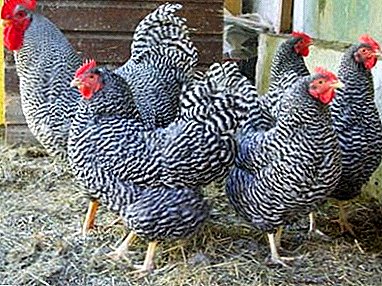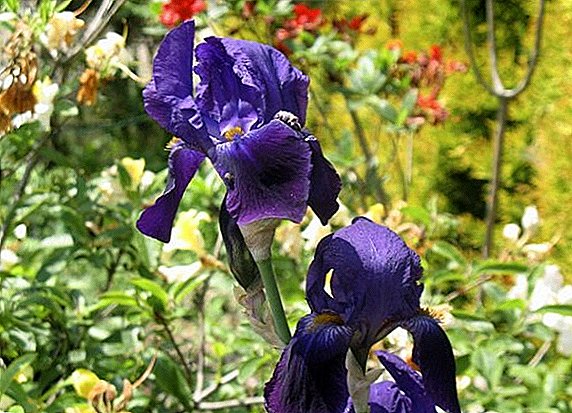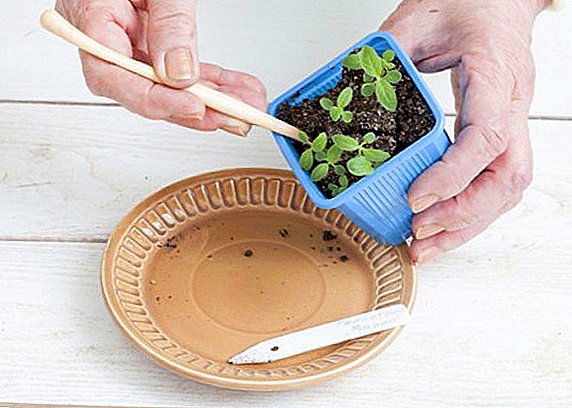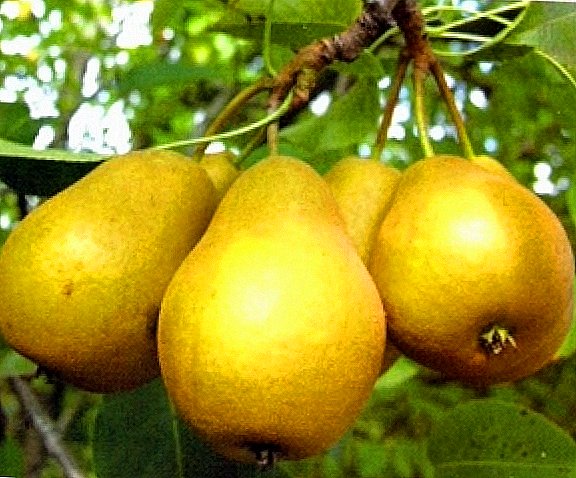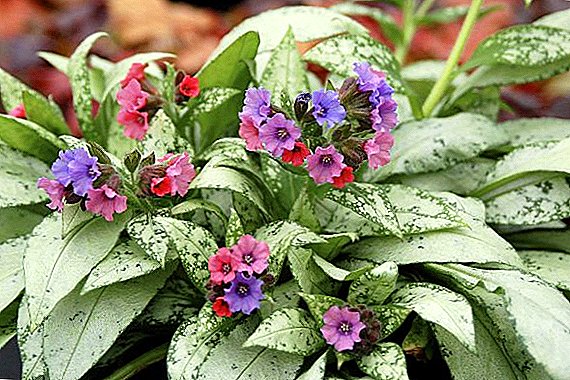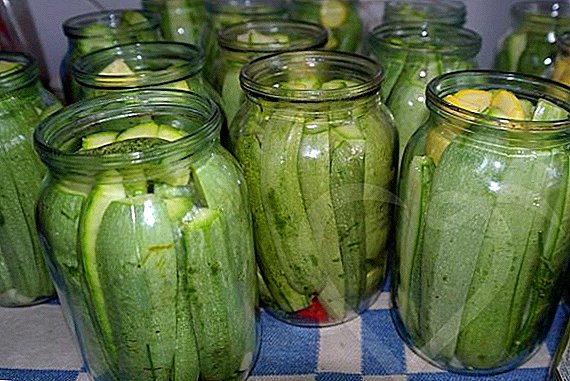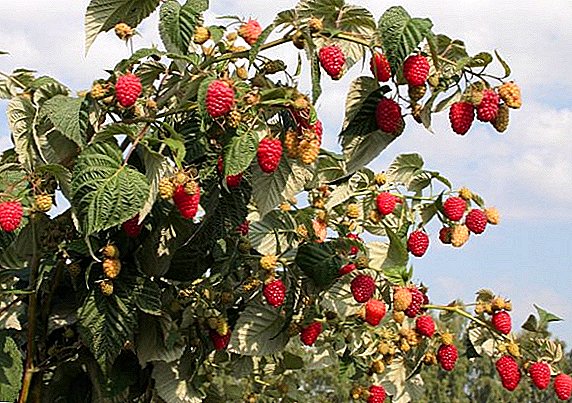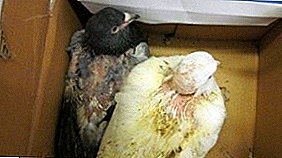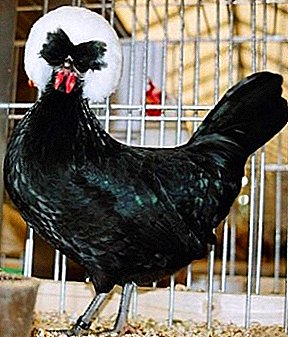
Both an experienced poultry breeder and a man in the street cannot help but pick out a Dutch woman from all breeds of chickens, pleasing the eye with its extraordinary appearance and amusing the owners with a fairly decent number of eggs and the ability to use these chickens as representatives of meat breed.
Ornamental breeds of chickens are usually bred for aesthetic purposes: to admire. A small Dutch girl, besides beauty, can also give eggs and meat.
Actually, the Dutch white-crested breed was not originally planned as a decorative.
Now the Dutch breed is known as Belohokhlay, but in the XV century (the period when these chickens were first mentioned) there was no tuft and there was no trace.
The standard-looking poultry was recognizable except by the color of its plumage — black or dark brown, occasionally with red feathers against the background of the prevailing dark color.
It was bred in Holland in order to obtain from it a large amount of meat and eggs. And, in the first decades of its existence, the breed one hundred percent justified the task entrusted to it.
However, the man intervened. In pursuit of the beauty and recognizability of the Dutch breed of chickens, the breeders decided to experiment and cross them with the Polish crested hen.
The result of the experiment: black chickens got white gorgeous tuft, attracting eyes, but their egg production fell somewhat. And Dutch chickens, becoming crested, give much less meat.
But, having acquired such an exotic look, the Dutch crested hen became a popular symbol of the country and a favorite living decoration of rich estates. Images of these birds can be found on the canvases of outstanding artists of the sixteenth century.
Description of the breed Dutch white-crested
 There is another unofficial name for the representatives of this breed: chicken with a hairstyle.
There is another unofficial name for the representatives of this breed: chicken with a hairstyle.
The white crest so evenly falls on both sides of the bird's head, creating the impression of an original styling, which seems to be the professional image of the hairdresser’s image.
The crest is large and dense, despite the length of the feathers, it does not block the eyes and does not prevent the bird from looking. The fore feathers of the tuft are usually dark and form on the forehead (at the base of the beak) a butterfly-like pattern.
This unique pattern gives the Dutch crested hens even more charm, and it also determines the purity of the breed. But, basically, as the crest: the bigger it is and the snow-white, the purer the breed.
The crest on the head of the hens of the Dutch breed is absent, it was successfully replaced by the mentioned crest, but the "earrings" (tarsus), large and bright, stand out particularly in roosters.
The earlobes of Dutch Crested Chickens are small, white in color, the beak is also small and not long, in color, usually corresponds to the basic range of plumage color. The eyes are red or brown, the face is featherless, red.
 Dakan - a breed of chickens grown in Central Asia, have a rather nasty character.
Dakan - a breed of chickens grown in Central Asia, have a rather nasty character.
But how to cook corn in the Redmond multicooker, you can always read here!
The body of the Dutch chickens is quite compact, retracted, with a well-developed belly and graceful shins. The plumage fits tightly to the body, without forming "pillows."
In addition to the crest, the Dutch hens have another decoration: the tail of this breed is very beautifully curved, even though the tail feathers are rather flattened. Highly but not steeply set at an angle of 4500, covering feathers give it pomp.
Chickens are of medium size, the weight of a rooster is 2-2.5 kilograms, hens - 1.5-2 kilograms.
March hens begin to sweep in Septemberand if we look at the Dutch white-crested through the prism of breeding this breed in a private yard, then an ordinary hen can easily be reincarnated into a beautiful hen.
Modern breeders distinguish three main colors of Dutch hens - black, brown and gray-blue.
Features breeding and content
 For several centuries of its existence, the Dutch crested hen has gained popularity not only in its homeland, but also in all countries of Europe.
For several centuries of its existence, the Dutch crested hen has gained popularity not only in its homeland, but also in all countries of Europe.
The breed spread very quickly: several centuries ago, and now the breeders are happy to start growing these chickens.
Like any other animal, Dutch chickens require increased attention and care. Therefore, it cannot be argued that growing chickpea chickens is easy and simple.
- The “Dutchwoman”, to a great regret, belongs to the painful breeds, therefore, the young need not only be nurtured, they need, in the literal sense, to nurse. But even with great effort and the creation of all the necessary conditions, a certain percentage of chickens do not survive.
- Neighborhood with other breeds of hens does not tolerate the Dutch crested hen. Especially does not get along with the usual homemade chicken. And if you are seriously going to breed Dutch chickens, take care of a separate room for them.
- This breed of chickens loves space, cramped rooms - not for her, wet and dirty - too. The main condition for the maintenance of "Dutch" - cleanliness, dryness, spaciousness.
- White-crested Dutch chickens, despite the fact that their selection was made in the northern country, can not stand the cold and will not survive in an unheated hen house.
- Feed for Dutch chickens needs a bit, however, they are picky about food.
The uniqueness of the tuft
 Since this unique "hat" is the main "highlight" of Dutch hens and a decisive factor in determining the purity of the breed, it will be appropriate to pay special attention to it.
Since this unique "hat" is the main "highlight" of Dutch hens and a decisive factor in determining the purity of the breed, it will be appropriate to pay special attention to it.
So, in the Dutch crested, the breed of which is not "diluted" by any other, the crest is huge and snow-white. Pay attention to this when buying a chicken, because the productivity of eggs and meat depends on the purity of the breed.
For years, debate continues among Dutch pea-breeding planters: whether it is worth periodically cutting a tuft of chicken, giving it a neater and well-groomed appearance.
One part of the opponents is inclined to think that a haircut is obligatory, because it will not allow the “cap” to grow too large and create some discomfort for the chicken (for example, to stare his eyes); the other is convinced that nature itself took care of the comfort of the bird and the person does not need to interfere in this plan.
As for maintaining the white of a tuft, everyone here agrees: it is imperative to wash it. In order that the color is not "lost" - once a week.
And if such a procedure seems too frequent for the bird or for the owner, then bathe your chickens as the “hairstyle” gets dirty. However, in this case, the crest in dazzling whiteness will not differ.
But, before breeding "Dutch", create appropriate conditions for the hens of this breed:
- Separate warmed, dry and clean chicken coop.
- Minimum "communication" with chickens of other breeds.
- Give them the opportunity to walk in the wild as often as possible. That is, the paddock should be as large as possible.
- Remember that Dutch white chickens have a very weak immunity. If one individual becomes ill, then all measures must be taken urgently so that the others do not become infected.
- When buying chickens of this breed, make sure that the tuft of chickens is large and snow-white. If it is not possible to see the birds live, ask the seller for a photo and check the reputation of the farming enterprise.
A photo
Handsome black cock proudly flaunts the sun:
But in this photo you see a beautiful sample of blue standing on top of the fence:
This picture shows the classic black Dutch Crested Chickens:
The male and female walk in the outside yard at sunset:
A black rooster with a beautiful tuft flaunts against the background of the fence in front of the camera:
Excellent photo of a rooster and gray hen at close range:
Walk in the yard in search of fresh and lively food:
Where are these chickens bred?
 Among breeders, even experienced ones, a rare farmer will take care of a large batch of Dutch white-and-white - too picky a breed. But there are several addresses where you can find for yourself these chickens with indicators corresponding to the purity of the breed.
Among breeders, even experienced ones, a rare farmer will take care of a large batch of Dutch white-and-white - too picky a breed. But there are several addresses where you can find for yourself these chickens with indicators corresponding to the purity of the breed.
- Farm "Kurkurovo". Moscow region, Lyhovitsky district, village Kyrovo, d.33. Phone: +7 (985) 200-70-00.
- Farm "Merry Ryaba". Kurgan, st. Omskaya, 144. Phone: +7 (919) 575-16-61, e-mail: [email protected]
- Farm "Poultry". Moscow region, village Poyarkovo, Leningradskoye highway, 14 km. Phones: +7 (925) 277-97-15; +7 (962) 988-27-70.
With the quality care, hen-crested hens bring to their owner both moral and material satisfaction. And to breed this breed is only due to the fact that it is one of the most interesting breeds of poultry.
Analogs
 There is another kind of Dutch white-and-white - dwarf breed. These chicks exactly repeat the features of their "elder brother", however, they differ markedly in weight and egg production.
There is another kind of Dutch white-and-white - dwarf breed. These chicks exactly repeat the features of their "elder brother", however, they differ markedly in weight and egg production.
For a year, the laying hen of a dwarf breed is capable of laying about 80 eggs with an average weight of one 30 grams. At the same time she herself weighs 0.8 kilograms. The cockerel is slightly larger than a chicken - 0.9 kilograms - but also not an athlete. However, it is a fairly strong breed, able to compete with representatives of other breeds, both dwarf and of normal size.
Outwardly, the dwarf Dutchwoman even wins against the larger Dutch white-withered due to its miniature. After all, it is such a touching sight: a small graceful chicken with a large tuft. It was the little crested insects that took root in the parks, as their main decoration.
By color, dwarf tufts are black-and-white-spotty and striped, which also looks very original.
 In the photo chicken Phoenix looks charming! And in life - even better! At first glance you will be amazed!
In the photo chicken Phoenix looks charming! And in life - even better! At first glance you will be amazed!
You can see great photos of geraniums on our website at: //selo.guru/rastenievodstvo/geran/poleznye-svojstva.html.
The breed is also famous among the crested Dutch dwarf bantamok. They differ from the previous ones on the head and crest, and comb. The back of these chickens tapers towards the tail, so they look "broad-shouldered."
Their main distinguishing feature: bentams are not very similar to ordinary domestic chickens. Some kind of fabulousness is too traced and prevails in this breed.
Unusual "aspidovogo" color, with a red crown of the comb and crest curly such chicken can not be a simple poultry, because attracts the attention of lovers of the exotic and breed it not for meat and not for eggs.
It should be noted that this beauty has a number of significant difficulties in the content.
First of all, her tuft prevents her from contemplating the world, touches the ground during feeding and therefore becomes very quickly contaminated, and during the frosty period it freezes, turning from a lush hat into a miserable icicle. But at the same time, the icicle is also heavy, preventing the hen from keeping its head.
White-crested bentams also have a very strange habit of pulling out feathers from each other. Sometimes this innocent passion goes so far that they stop only when the head of a neighbor or a neighbor in a hen house turns out to be completely bald.



